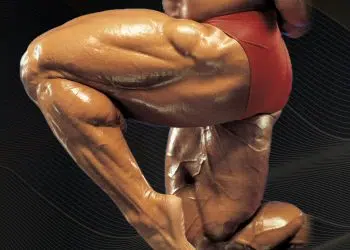Lack of time can be a major barrier to exercising regularly. After all, even a simple workout can be very time-consuming.
One way to make your workouts more time-efficient is to perform compound and hybrid exercises. Compound exercises involve multiple muscle groups, while hybrid exercises combine two more move movements.
Examples of hybrid exercises include:
- Front squat to push-press (aka thrusters)
- Barbell Romanian deadlift and bent over row
- Dumbbell curl and press
- Dumbbell lunge and side lateral raise
- Dumbbell fly and press
And now you can add another exercise to your list of hybrid movements – the bird dog row.
This exercise is not just very time-efficient; it’s also a highly challenging and functional upper-body and core exercise.
In this guide, we reveal why and how to do the bird dog row. Try it; you’re gonna like it!
Level Up Your Fitness: Join our 💪 strong community in Fitness Volt Newsletter. Get daily inspiration, expert-backed workouts, nutrition tips, the latest in strength sports, and the support you need to reach your goals. Subscribe for free!
Bird Dog Rows – Muscles Worked
There is a lot going on during bird dog rows. After all, it combines two exercises in one – the single-arm dumbbell row and the bird dog. Because of this, the bird dog row involves several important muscles.
The main muscles trained during bird dog rows are:
Latissimus dorsi
Like all rowing exercises, bird dog rows provide your latissimus dorsi (lats) with a good workout. Your lats are the muscles on the side of your upper back. The primary functions of your lats are shoulder extension, adduction, and medial rotation. When well developed, the lats look like wings and are responsible for the width of your back and V-taper.
Trapezius
The trapezius (traps) is a large, diamond-shaped muscle that covers much of your upper back. It’s responsible for elevation, depression, and retraction of your shoulder girdle. The traps are made up of three sets of fibers – upper, middle, and lower. The middle traps are the most active during bird dog rows.
Rhomboids
Located beneath the middle traps, the rhomboids are responsible for pulling your shoulders back and together. The rhomboids are important postural muscles.
Deltoids
The deltoids are your shoulder muscles. Known as the delts for short, there are three sets of deltoid fibers or heads – anterior (front), medial (side/middle), and posterior (rear). All three deltoid heads are engaged during bird dog rows, but the posterior delt is the most active.
Biceps brachii
Located on the front of your upper arm, the biceps brachii flexes your elbow as you row the weight up and into your body. The biceps are arguably the most famous muscle in the human body, and even non-exercisers can usually identify it.
Core
Core is the collective term for the muscles of your midsection, including the rectus abdominis, obliques, transverse abdominis, and erector spinae. These muscles contract inward to create intra-abdominal pressure to stabilize your spine. Bird dog rows are a very core-centric exercise, so expect to feel them in your abs and waist.
Gluteus maximus
Known as the glutes for short, this is the largest and potentially most powerful muscle in the human body. During bird dog rows, you use your glutes to extend your non-working leg out behind you.
Hamstrings
There are three muscles in the hamstring group – semimembranosus, semitendinosus, and biceps femoris. The hamstrings work with your glutes to extend your non-working leg during bird dogs.
How to Do Bird Dog Rows
Get more from bird dog rows while keeping your risk of injury to a minimum by following these guidelines:
- Place one hand and your opposite knee on an exercise bench. Extend your other leg out behind you as a counterbalance. Brace your core.
- Hold a dumbbell in your non-supporting hand, and let your arm hang straight down. Pull your shoulder back and down. Rotate your wrist, so your palm is turned inward.
- Without lowering your leg or twisting your hips or shoulders, bend your arm and row the weight up and into your lower ribs. Keep your wrist straight and lead with your elbow.
- Smoothly extend your elbow and lower the weight back down to arms’ length.
- Repeat for the desired number of reps, rest a moment, change sides, and repeat.
- Try to do the same number of reps on both sides.
Tips:
- Don’t go too heavy too soon. Using too much weight could cause you to lose your balance and bring your set to a premature end.
- Use a kettlebell instead of a dumbbell. The lower center of gravity may make maintaining your balance somewhat easier.
- Grip the edge of the bench with your supporting hand to increase stability.
- Maintain a slight arch on your lower back but take care not to hyperextend your spine by raising your leg too high.
Bird Dog Row Benefits
Not sure if the bird dog row deserves a place in your workout? Don’t turn your back on it just yet; consider these benefits and then decide!
- A functional exercise – the bird dog row involves core stability combined with an upper-body pull. This is a very functional movement. If you play contact sports, are involved in martial arts, are a climber, or otherwise perform any athletic activities, this exercise could improve your performance.
- Very time-efficient – bird dog rows involve a lot of significant muscle groups, including your back, core, and posterior chain. If you want to get a lot done in a short time, the bird dog row is an excellent option. Add a few sets of push-ups and goblet squats, and you have a full-body workout in just three exercises.
- Good for developing balance and coordination – there is no denying that the bird dog row is a technically challenging exercise. Not only do you need to keep your leg lifted and your core tight, but you need to coordinate a rowing movement, too. Such an involving exercise will do your neuromuscular system a whole lot of good.
- Forces you to row with good technique – single-arm rows are often performed with poor technique. People try to lift too much weight and do their reps too quickly. If you make these mistakes during bird dog rows, you’ll probably lose your balance and fall off the bench. Bird dog rows force you to use moderate weights and a slow, smooth lifting tempo. This exercise won’t work if you cheat!
- Very lower back-friendly – a lot of horizontal rowing exercises are hard on your lower back. Brid dog rows put your lower back in a mechanically sound position and make it easier to maintain it. As such, this is a good exercise for anyone with a history of or who wants to avoid lower back pain.
- Minimal equipment required – all you need to do bird dog rows is a single dumbbell or kettlebell and a bench. However, despite being so accessible and low-tech, this is still an effective and worthwhile exercise.
Drawbacks
While bird dog rows are a mostly beneficial exercise, there are also a couple of drawbacks to consider:
- Not really suitable for heavy weights – using a heavy weight will make bird dog rows almost impossible to do correctly. The weight will pull you into rotation, and you’ll probably lose your balance. As such, this exercise is best done with light to moderate weights and medium to high reps.
- Requires decent levels of balance and core stability – this is a technically demanding exercise that may be beyond the reach of some beginner and even early intermediate exercisers. You need to master regular bird dogs and single-arm dumbbell rows before attempting this exercise.
7 Bird Dog Row Variations and Alternatives
Bird dog rows are a highly effective back and core exercise, but that doesn’t mean you need to do them all the time. There are several variations and alternatives you can use to keep your workouts productive and interesting:
1. Bird dog rows (floor version)
While regular bird dog rows are an excellent exercise, you need a bench and good balance to do them correctly. No bench? Poor balance? Not a problem! You can also do this movement on the floor. This variation is considerably easier, making it an ideal stepping stone to bench bird dog rows.
Steps:
- Kneel on the floor on all fours. Your hands should be directly under your shoulders and your knees under your hips. Rest one hand on a dumbbell and extend your opposite leg out behind you. Brace your abs and pull your shoulders down and back.
- Without lowering your leg, bend your elbow and row the dumbbell up and into your lower ribs.
- Lower the dumbbell back to the floor and repeat.
- On completion of your set, rest for a moment, switch sides and do the same number of reps with the other arm.
Muscles targeted:
- Primary: Latissimus dorsi, biceps, core.
- Secondary: Trapezius, rhomboids, deltoids.
Benefits:
- Less balance requirement than bench bird dog rows.
- A good exercise for beginners.
- No bench is required, so a great option for home exercisers.
Tips:
- Use small-diameter weight plates to maximize your range of motion.
- Place your supporting hand on a low platform, e.g., a bumper plate, to allow you to fully extend your working arm.
- Keep both knees on the floor if your core is not strong enough to stabilize your hips and spine.
2. Renegade row (aka plank or push-up row)
The renegade row is a step up from the bird dog row. With this exercise, you use two dumbbells and an alternating arm action to train your core and lats. However, there is no significant glute or hamstring recruitment in this movement.
Level Up Your Fitness: Join our 💪 strong community in Fitness Volt Newsletter. Get daily inspiration, expert-backed workouts, nutrition tips, the latest in strength sports, and the support you need to reach your goals. Subscribe for free!
Steps:
- Hold a dumbbell in each hand. You can also use kettlebells. Squat down and place the weights on the floor roughly shoulder-width apart.
- Brace your abs and walk your feet out and back into the push-up position. Your body should form a straight line. Keep your wrists straight, and do not allow them to collapse.
- Move your feet out so that they are wider than shoulder-width apart to increase balance and stability. Look straight down at the floor to ensure your neck is neutral.
- Keeping one arm straight, bend the other arm and row the weight up and into your lower ribs. Do NOT allow your hips or shoulders to twist.
- Lower the weight back to the floor, swap sides, and repeat. Alternate arms for the duration of your set, keeping your core braced throughout.
Muscles targeted:
- Primary: Latissimus dorsi, biceps, core.
- Secondary: Deltoids, triceps.
Benefits:
- A very challenging exercise.
- A useful progression if you have mastered bird dog rows.
- You only need two dumbbells to do this exercise – no bench is required.
Tips:
- Do this exercise with your legs bent and knees resting on the floor to take pressure off your core.
- Use hex-shaped dumbbells if available, as they’re easier to control.
- Add a push-up between rows to work your chest as well as your back and core.
3. Bear crawl renegade row
Renegade rows are typically done with straight legs. However, that doesn’t mean you have to do them that way. Bending your legs shifts your weight forward and changes the feel of this exercise entirely. Try both variations to see which one you enjoy the most.
Steps:
- Kneel down on all fours with a dumbbell in each hand. Your shoulders should be directly over your hands and your hips over your knees. Look down toward the floor so your neck is neutral. Brace your abs.
- Keeping your legs bent, lift your knees off the floor, so your weight is on your hands and the balls of your feet only. This is called a bear plank.
- Maintaining core stability and without twisting your hips or shoulders, row one dumbbell up into your lower ribs and then put it back down again. Do your next rep with the opposite arm.
- Continue alternating sides for the duration of your set.
Muscles targeted:
- Primary: Latissimus dorsi, biceps, core.
- Secondary: Deltoids, triceps.
Benefits:
- A functional core and upper body pulling exercise.
- Teaches you to brace your core to maintain a neutral spine during upper-body pulling exercises.
- No bench required, so this movement is ideal for home exercisers.
Tips:
- Start light – this is a challenging exercise.
- Use hex-shaped dumbbells if available, as they’re easier to control.
- Combine with forward and backward bear crawls for an even more demanding workout.
4. Half-kneeling single-arm cable row
Balance can be a real problem with bird dog rows. Get around that problem while working the same muscles with the half-kneeling single-arm cable row. This exercise is every bit as effective but much less technically demanding.
Steps:
- Attach a D-shaped handle to a low pulley machine. Adopt a half-kneeling position and grab the handle with one hand.
- Extend your arm out in front of you and move back to tension the cable. Brace your abs and pull your shoulders back and down.
- Bend your arm and, leading with your elbow, pull the handle into your lower ribs.
- Extend your arm and repeat.
- Do the same number of reps with your other arm, remembering to reverse your leg position when you swap arms.
Muscles targeted:
- Primary: Latissimus dorsi, biceps, core.
- Secondary: Deltoids, trapezius, rhomboids.
Benefits:
- Requires far less balance than bird dog rows.
- Using cables keeps your muscles under constant tension.
- Cable exercises are perfect for muscle-building drop sets.
Tips:
- You can also do this exercise with a resistance band.
- Drive your elbow back to maximize back engagement.
- Add a torso twist to increase oblique and core engagement.
5. Unsupported single-arm bent-over dumbbell row
The bent-over row is usually done with a barbell. However, switching to a single-arm variation increases core and oblique engagement, making it more like bird dog rows. However, take care not to round your lower back during this exercise, as doing so could increase your risk of injury.
Steps:
- Stand with your feet about hip-width apart and hold a dumbbell in one hand. Brace your abs, bend your knees slightly, and pull your shoulders down and back.
- Hinging from the hips, lean forward, so your upper body is inclined to about 45 degrees. Let your arm hang down from your shoulder, palm facing inward.
- Without twisting your hips or shoulders, bend your arm and row the weight up and into your lower ribs.
- Extend your arm and repeat.
- Rest a moment to allow your lower back to recover, swap sides, and repeat. Do the same number of reps on both sides.
Muscles targeted:
- Primary: Latissimus dorsi, biceps, trapezius, rhomboids, deltoids.
- Secondary: Erector spinae, gluteus maximus, hamstrings.
Benefits:
- A more challenging exercise than bird dog rows.
- A low-tech but high-effect exercise that requires just one dumbbell and no bench.
- An effective anti-rotation core exercise.
Tips:
- Think about leading with your elbow and squeezing your shoulders down and back to maximize back engagement.
- Use a kettlebell instead of a dumbbell for a thicker grip and a more challenging forearm workout.
- Set the dumbbell on the floor between reps so you can rest your core and grip and lift heavier weights. This is called a single-arm Pendlay row.
6. Side plank cable row
Side plank cable rows work all the same muscles as bird dog rows. However, they hit many of those muscles laterally, i.e., from the side. This is a good option for anyone who finds it hard to maintain their balance during bird dog rows and is looking for a slightly easier but no less effective alternative.
Steps:
- Attach a D-shaped handle to a low pulley machine. Lie on your side in front of the pulley and rest your weight on your lowermost forearm.
- Grip the handle with your uppermost hand and then lift your hips, so you are in a side plank position. Brace your abs and make sure your body is straight.
- Bend your arm and pull the handle into your lower ribs.
- Extend your arm and repeat.
- Swap sides and repeat, ensuring that you do the same number of reps with both arms.
Muscles targeted:
- Primary: Latissimus dorsi, trapezius, rhomboids, obliques, biceps.
- Secondary: Hip abductors, gluteus maximus.
Benefits:
- An excellent exercise for your lateral support chain.
- Very lower back friendly.
- A slightly less technical exercise than bird dog rows.
Tips:
- Rest your elbow and forearm on a folded mat or foam pad for comfort.
- Keep your hips and shoulders square throughout.
- You can also do this exercise with a resistance band, which is an excellent at-home core and lat movement.
7. Suitcase deadlift
This exercise is so-called because, when you do it, you look like you are picking up a suitcase or grocery bag. The suitcase deadlift works many of the same muscles as bird dog rows, but your legs have a more important part to play. Also, your lats work isometrically or statically instead of dynamically.
Steps:
- Place a dumbbell on the floor and stand next to it, so the handle runs parallel to your feet. Stand with your feet about hip-width apart.
- Squat down and grip the dumbbell with an overhand grip so your thumb is pointing forward. Straighten your arm.
- Drop your hips, lift your chest, and slightly arch your lower back. Look straight ahead and brace your abs.
- Without rounding your back or leaning to the side, drive your feet into the floor and stand up. Keep your abs braced, working hard to keep your torso perfectly upright.
- Push your hips back, bend your knees, and lower the weight smoothly back to the floor. Reset your core and repeat.
- Rest a moment at the end of your set, and then swap sides. Try to do the same number of reps on each side.
Muscles targeted:
- Primary: Quadriceps, hamstrings, gluteus maximus, latissimus dorsi, forearms, core.
- Secondary: Deltoids, biceps.
Benefits:
- Increased lateral core engagement.
- Build a stronger grip.
- Fix left to right strength imbalances.
Tips:
- Place the dumbbell on a mid-shin height platform to make it more comfortable to pick up.
- You can also do this exercise with a barbell or kettlebell.
- Stand on a bumper plate to increase your range of motion and make this exercise much harder.
Bird Dog Row FAQs
Do you have questions about bird dog rows? We’ve got the answers you are looking for!
1. Is the bird dog row a lat or a core exercise?
Believe it or not, bird dog rows are a lat AND core exercise. Rowing the weight into your body engages your lats while your core stabilizes your lumbar spine. In addition, your glutes and hamstrings get in on the act as they work to hold your non-supporting leg out level with the floor.
So, really, bird dog rows are a lat, core, glute, and hamstring exercise, which is why it’s so effective.
2. How many reps and sets of bird dog rows should I do?
Bird dog rows are not a great exercise for heavy weights and low reps. In fact, you’ll probably get the best results from this movement if you use light to moderate weights and do medium to high reps. For example, 12-20 reps per set is a good place to start.
In terms of sets, 2-4 should be plenty. If you feel you can do more than four sets, you are probably resting too long, not using enough weight, or stopping your sets too far away from failure. Crank up the intensity, and you won’t need or want to do as many sets.
3. What weight should I use for bird dog rows?
Unfortunately, this is one of those questions that’s impossible to answer. After all, we don’t know how strong you are or how many reps you plan on doing. However, it would be best to use a weight that takes you close to failure in the 12-20 repetition range.
That said, if you are new to bird dog rows, you should start light and increase the load gradually as you get used to the exercise. Bird dog rows are more challenging than they look!
4. How often should I do bird dog rows?
Because you won’t be using heavy weights, bird dog rows shouldn’t be too intense, and you will recover pretty quickly after doing them. So, you can probably do them 2-3 times per week, with a day of rest in between.
However, you will soon get bored of them if you do bird dog rows too often. Instead, use the variations and alternatives described above to train the same muscle groups while keeping your workouts interesting and productive.
5. I have one arm stronger than the other, so my reps are not the same on both sides. Is this a problem?
Left-to-right strength imbalances are pretty common, but if they’re allowed to become too great, you may end up with uneven muscular development and postural issues. So, if you notice that one arm is stronger than the other during bird dog rows, you should endeavor to even things out.
The most straightforward way to do this is to train your weaker arm first and then match the number of reps performed with your stronger arm. Let your weak side determine how many reps you do.
Gradually, as your weaker arm gets stronger, you should find your development evens out. You could also do an extra set or two per workout for your weaker side.
Bird Dog Rows – Wrapping Up
Bird dog rows are not a very common exercise. In fact, you may not have seen anyone performing them before. That’s a shame because they’re a valuable and effective exercise for targeting your back, core, and lower body posterior chain.
This is not an exercise for building Hulk-like strength. Instead, it’s an excellent functional exercise that will improve your balance, coordination, and stability.
Use it as a warm-up before other types of rows or as a finisher at the end of your upper body pulling workout. Alternatively, use it during deload weeks.
Interested in measuring your progress? Check out our strength standards for Push Ups, Dumbbell Curl, Pendlay Row, and more.








